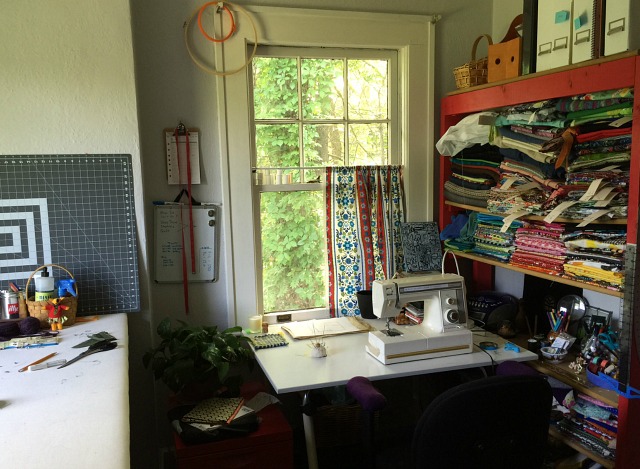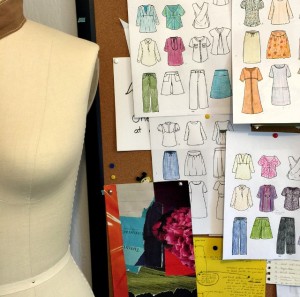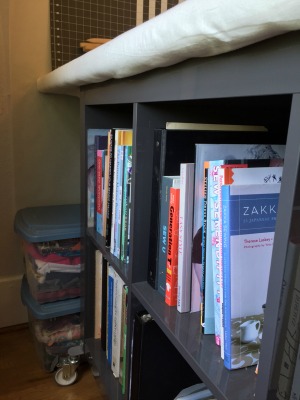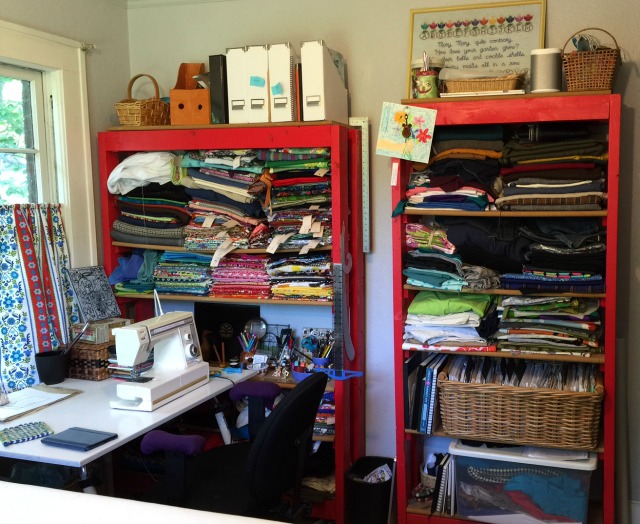Maybe you’re familiar with the magazine “Where Women Create“. It’s a magazine filled with photos of crafty women’s studios. As their website says, “Where Women Create magazine invites you into the creative spaces of the most extraordinary women of our time.”
The first time I saw this magazine I had a hard time believing this is what people wanted to read. But now I kind of get it. It’s like snooping with out consequences while discovering how “extraordinary women” tackle the same problem you have; too much fabric.
Even though “Where Women Create” has shown no interest in showcasing my sewing room I wanted to share my little space with you anyway. This is where the sewing part of The Daily Sew takes place (and the planning, cutting and seam ripping). Welcome.

The smallest bedroom in the house was originally going to be my husband’s office nine years ago when we moved in but the wireless connection was poor at best upstairs so he settled into the sun room. I was very excited, and still am grateful, to get a room for sewing. I was in the dungeon in our previous house (a dark, damp basement) and the dining table in the apartment before then. Sacrificing a sun room for the family to hang out in was no sacrifice for me.
As soon as you enter the room you will see, directly in front of you, my sewing machine. I got it in 1990, before I studied fashion design. It’s a New Home machine; sturdy and basic and missing it’s manual. I’ve used it exclusively all these years for my personal sewing and even on school assignments. Lately my machine seems extra sensitive to lint and wants to be cleaned more often. It tells me this by way of an odd, and disturbing, clanking sound. I am wondering if it’s time for a new machine but it’s hard to let go.
Ol’ trusty sits on my drafting table; the desk my mom bought for me when I started art school years ago. I have made so many things at this desk, masterpieces and mistakes. When I sit at it I feel settled and ready to make the next thing. However, it really is just a table and has no drawers so next to it I have a rolling file drawer for my everyday sewing supplies such as scissors, fray check and marking tools.

Once, in a fabric store, I saw some beautiful, rainbow colored, felted pincushions. They triggered that “I can make that” track in my head. Here is my attempt to make a felt pincushion. I gave up early and didn’t even try to add colors. The friend showing me how to felt placed the little tan felt ball she made on my blob. She poked in pins for eyes and announced we had a little figure. Not at all what I had in mind but I like it.

This is the view from my sewing table. I like looking out onto the trees. I have started a spool graveyard on the window sash. I’m saving them to use in fidget blankets for Alzheimer patients once I find a place that l can donate fidget blankets to.

My work table is made of two IKEA cubby type bookshelves placed back to back and topped with a interior door that I’ve padded and covered in muslin. It’s a good height for cutting, pressing and working at. It juts out into the room so that I am able to walk around three sides of it.
The back window also allows me to look out onto tree branches and yard. It faces north and gets a nice breeze. I love the days when I can pop the screen in and feel as if I’m working outside. The closet in this room is not much of a closet. It is not even deep enough to hang a hanger in sideways. Because of this I don’t really use it except to tuck batting and a bin of felt into. The outside of the closet however is used like a bulletin board with post its for each project I want to do.
 The real bulletin board hangs next to the closet. It also has projects I want to do. (Apparently I need a lot of reminders to stay focused. Maybe I will make a fidget blanket for myself.) This last spring I went through the patterns I owned and the fabric I owned and drew out garments I wanted and could make with what I already had. This exercise made me realize I may never need to buy print fabric again.
The real bulletin board hangs next to the closet. It also has projects I want to do. (Apparently I need a lot of reminders to stay focused. Maybe I will make a fidget blanket for myself.) This last spring I went through the patterns I owned and the fabric I owned and drew out garments I wanted and could make with what I already had. This exercise made me realize I may never need to buy print fabric again.

In four of the cubbies of the front bookshelf I’ve placed drawers for thread, notions and pressing tools. I separated the thread into three different drawers by cool colors, neutrals, and warm colors. I have noticed spools prefer to hide in the back of the drawers and as they roll around with the opening and closing of the drawer they like to unravel and mingle with each other. It seemed like a good idea to store them in drawers. One day I will put narrow shelves along the walls and line the spools up on them.
 The bookshelf that runs along the back of the table holds sewing related books. I buy most of my sewing books from our local used book store. Basic art supplies are also on the back bookshelf.
The bookshelf that runs along the back of the table holds sewing related books. I buy most of my sewing books from our local used book store. Basic art supplies are also on the back bookshelf.
My scrap fabric is placed in bins and tucked under the table. Large size scraps in one bin and small scraps in the other bin. I do limit myself to these two bins and once in awhile I have to toss lesser loved fabric scraps when the lid will no longer snap shut.

On top of the work table I keep water for the ironing (the dish soap squeeze bottle makes it easy to get water into the iron), pattern weights (in a coffee can), and the sleeve board. I’m learning to crochet so naturally that is parked on the work table.
The felt dog is my daughter’s. It’s waiting to get a loop sewn onto it so it can be an ornament now that my daughter is all grown up. Confession; that dog has been waiting for a loop for over a year now. I like it’s smiling face keeping guard over the water supply.

Other than the scraps two tall shelves hold all of my fabric with out taking up a lot of floor space.The plastic bin on the shelf is for fabric that I want to be certain no moth or other critter will feast upon. Rulers hang from small nails. Magazines and extra supplies are on the top shelves and pens, markers, and a cd player are next to the desk.
The large basket holds my patterns. It’s wide enough to fit two standard size pattern envelopes side by side (McCalls, Butterick…that size) and one Hot Patterns pattern sideways. I’ve divided them with pieces of tag board into categories such as “skirts” “pants” “tops”. For patterns with multiple garments covering more than one category I filed it under the garment I bought the pattern for.

Oh, and there is my diploma, behind Rolf the Dog and a clay rabbit my son made; hey, priorities.

And then there is Basso, my dog. He is a constant companion and couldn’t possibly be kept out of here even though he often lays right where I need to stand or makes it difficult to slide my chair out or both at the same time. We work it out but I never complain if he gets up and moves into the hall.
I like my space and appreciate having it but there is always room for improvement. The fantasy wish list for my sewing space includes better lighting, more electrical outlets (and modern ones) and a little more elbow room now that Basso is part of the sewing experience.
This is where The Daily Sew sews and where I am headed to right now.

I loved reading your article and having an opportunity to tour your studio space. Though glass, instead of textiles, is my medium, I’m enlightened by different ideas on how I might organize. Thanks!
Thank you. I’ve recently been thinking of how I can improve the work area to be more efficient. Thinking of moving things around. I have two big challenges to my space. One is that I want to be able to stand at both long sides of my work table. The other is I have only two electrical outlets (one has only one outlet) in the room. I need to plug in a sewing machine, iron, lights, something that provides music and a laptop. Once I use up some of my fabric stash I’ll have more room to play with.